________________
THE INDIAN ANTIQUARY
[APRIL, 1930
Then the man and the woman were faint, and the Great Mountain commanded them to mako a strong drink. This they made in the following manner. He gave them a handful of leaven, and badle then put it in a pitcher of water. After four days this had become a strong drink. He ordered them to drink it, but before doing so they were to make a libation of it.7
Seeing afterwards that the human race was liable to be exterminated, the Great Moun. tain made the man and woman get drunk with this strong drink. In their inebriate condition the first human pair copulated, as a result of which seven children were born to them these children soon multiplied, and became the forefathers of the Santal race.
The most ancient residence of the Santáls within their memory was pargana Ahuri in Hazûribagh district. From there they migrated west towards Khoj Kamân, where the greater part of them were destroyed on account of their wickedness. They say that during the first stage of human existence nearly the whole of the human race was destroyed by fire falling from heaven. After numerous other migrations they took up their abode at Cainpå, where they remained for several generations. Finally the Hindus drove them away from Campå, and they settle in Saont,10 where they reigned for a period of over two hun. dred years. From this last plave too they were driven away by the Hindus. They fled to Manbhûm, where their Raja adopted the Hindu faith. But the people were unwilling to accept the Hindu religion, so they left their king to reign over the Hindus, and themselves emigrated to the Santal Parganas, where they remain to the present day, 11 With regard to their migrations, Hunter saygls: "In this time (i.c., soon after the human race was multiplied) they dwelt in Hihiri Pipiri, but when the land could not hold them they journeyed to Chao Champa; and when Chae Champa would not hold them they journeyed to Silda ; and when Silda would not hold them they journeyed to Sikar, and from Sikar they journeyed to Nagpur, and from Nagpur to the north, even to Sir."
Although ethnologically the SantAls belong to the great Dravidian family of the human race, linguistically they are a branch of the Munda (once called 'Kolarian ') family 18 The principal occupation of the Santals is tilling the soil, and they cultivate principally rice, which is their staple food. As huntsmen they are alike skilful and intrepid ; their principal weapons for this sport are bows and arrows. The arrows are of two kinds: heavy, sbarp ones for the larger kinds of game, and light ones with a broad knob at the point for small birds. In their habits they may be called nomadic, but gradually they are settling down. They have a highly pronounced artistio sense; they are very fond of music and dancing, and are themselves great adepte with the flute-a native bamboo instrument with holes burned in it , and they play these flutes in a very melodious manner. As a rule the Santal women are extremely fond of finery as they understand by the term. A fully-equipped Santal ballo carries two anklets, and perhaps twelve bracelets, and a necklace weighing a pound, the total weight of ornaments on her person amounting to about thirty-four pounds of bell-metal. "A greater weight," says Sherwill, "than any one of our drawing room
1 (Sir) W. W. Hunter, Annals of Rural Bengal, pp. 148, 451.
. For stories of incestuous uniong Bee (Sir) J. G. Frazer, Pausanias'. Description of Greece (London, 1899). vol. ii. p. 85; E. Westermarck, The History of Human Marriage (New York, 1929), vol. iii, p. 631, .. v. "Incest"; E. Durkheim, "La prohibition de l'inceste," L' Arnde Sociologique, vol. i (1896-1897), and references quoted there.
B. Bonneriea, L'Ethnologie du Bengale, p. 21, quoting (Sir) J. G. Frazer. Folklore in the Old Testa. ment (London, 1919), vol. 1, p. 1961.
10 See (Sir) G. A. Grierson, Linguistic Survey of India, vol. iv (Caloutta, 1906), p. 30. 11 B. Bonnerjea, L'Ethnologie du Bengale, pp. 21 sq. 19 (Sir) W. W. Hunter, Annals of Rural Bengal, p. 149.
13 Seo Col. E. T. Dalton, Descriptive Ethnology of Bengal, p. 207: (Sir) H. H. Risley, Tribes and Castes of Bengal; Ethnographic Glossary (Calcutta, 1892), vol. ii, p. 224 f. : (Sir) G. A. Grionson, Linguistic Survy of India, vol. iv, p. 30; (Sir) J. G. Frazer, Tolemist and Exogamy, yol, ii, p. 300; B. Bonnerjes, L'Ethnologie du Bengale, p. 22.




